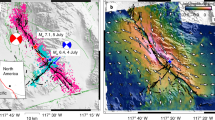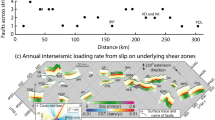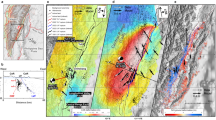Abstract
The 2010 Mw 7.2 El Mayor–Cucapah earthquake in Baja California, Mexico activated slip on multiple faults of diverse orientations1,2, which is commonly the case for large earthquakes3,4,5,6. The critical stress level for fault failure depends on fault orientation and is lowest for optimally oriented faults positioned approximately 30° to the greatest principal compressive stress7. Yet, misoriented faults whose positioning is not conducive to rupture are also common8,9. Here we use stress inversions of surface displacement and seismic data to show that the El Mayor–Cucapah earthquake initiated on a fault that, owing to its orientation, was among those that required the greatest stress for failure. Although other optimally oriented faults must have reached critical stress earlier in the interseismic period, Coulomb stress modelling shows that slip on these faults was initially muted because they were pinned, held in place by misoriented faults that helped regulate their slip. In this way, faults of diverse orientations could be maintained at critical stress without destabilizing the network. We propose that regional stress build-up continues until a misoriented keystone fault reaches its threshold and its failure then spreads spontaneously across the network in a large earthquake. Our keystone fault hypothesis explains seismogenic failure of severely misoriented faults such as the San Andreas fault and the entire class of low-angle normal faults.
This is a preview of subscription content, access via your institution
Access options
Subscribe to this journal
Receive 12 print issues and online access
$259.00 per year
only $21.58 per issue
Buy this article
- Purchase on Springer Link
- Instant access to full article PDF
Prices may be subject to local taxes which are calculated during checkout



Similar content being viewed by others
References
Fletcher, J. M. et al. Assembly of a large earthquake from a complex fault system: surface rupture kinematics of the 4 April 2010 El Mayor–Cucapah (Mexico) Mw 7.2 earthquake. Geosphere 10, 797–827 (2014).
Teran, O. J. et al. Geologic and structural controls on rupture zone fabric: a field-based study of the 2010 Mw 7.2 El Mayor–Cucapah earthquake surface rupture. Geosphere 11, 1–22 (2015).
Beroza, G. C. Near source modelling of the Loma Prieta earthquake: evidence for heterogeneous slip and implications for earthquake hazard. Bull. Seismol. Soc. Am. 81, 1603–1621 (1991).
Sieh, K. et al. Near-field investigations of the Landers earthquake sequence, April to July 1992. Science 260, 171–176 (1993).
Freed, A. M. & Lin, J. Delayed triggering of the 1999 Hector Mine earthquake by viscoelastic stress transfer. Nature 411, 180–183 (2001).
Field, E. H. et al. Uniform California Earthquake Rupture Forecast, Version 3 (UCERF3)–the time-independent model. Bull. Seismol. Soc. Am. 104, 1122–1180 (2014).
Morris, A., Ferrill, D. A. & Brent Henderson, D. B. Slip-tendency analysis and fault reactivation. Geology 24, 275–278 (1996).
Mount, V. S. & Suppe, J. State of stress near the San Andreas fault: implications for wrench tectonics. Geology 15, 1143–1146 (1987).
Axen, G. J. Low-angle normal fault earthquakes and triggering. Geophys. Res. Lett. 26, 3693–3696 (1999).
Hauksson, E. et al. The 2010 Mw 7.2 El Mayor–Cucapah earthquake sequence, Baja California, Mexico and southernmost California, USA: active seismotectonics along the Mexican Pacific margin. Pure Appl. Geophys. 168, 1255–1277 (2011).
Wei, S. et al. Superficial simplicity of the 2010 El Mayor–Cucapah earthquake of Baja California in Mexico. Nature Geosci. 4, 615–618 (2011).
Yang, W., Hauksson, E. & Shearer, P. M. Computing a large refined catalog of focal mechanisms for southern California (1981–2010): temporal stability of the style of faulting. Bull. Seismol. Soc. Am. 102, 1179–1194 (2012).
Oskin, M. E. et al. Near-field deformation from the El Mayor–Cucapah earthquake revealed by differential LIDAR. Science 335, 702–705 (2012).
Angelier, J. Determination of the mean principal directions of stresses for a given fault population. Tectonophysics 56, T17–T26 (1979).
Michael, A. J. Determination of stress from slip data: faults and folds. J. Geophys. Res. 89, 11517–11526 (1984).
Gephart, J. W. & Forsyth, D. W. An improved method for determining the regional stress tensor using earthquake focal mechanism data: application to the San Fernando earthquake sequence. J. Geophys. Res. 89, 9305–9320 (1984).
Michael, A. J. Use of focal mechanisms to determine stress: a control study. J. Geophys. Res. 92, 357–368 (1987).
Anderson, E. M. The dynamics of faulting. Trans. Edinburgh Geol. Soc. 8, 387–402 (1905).
Krantz, R. W. Measurements of friction coefficients and cohesion for faulting and fault reactivation in laboratory models using sand and sand mixtures. Tectonophysics 188, 203–207 (1991).
Tenthorey, E. & Cox, S. F. Cohesive strengthening of fault zones during the interseismic period: an experimental study. J. Geophys. Res. 111, B09202 (2006).
Byerlee, J. Friction of rocks. Pure Appl. Geophys. 116, 615–626 (1978).
Angelier, J. From orientation to magnitudes in paleostress determinations using fault slip data. J. Struct. Geol. 11, 37–50 (1989).
Nieto-Samaniego, A. F. & Alaniz-Alvarez, S. A. Influence of the structural framework on the origin of multiple fault patterns. J. Struct. Geol. 17, 1571–1577 (1995).
Lachenbruch, A. H. & Sass, J. H. The stress heat-flow paradox and thermal results from Cajon Pass. Geophys. Res. Lett. 15, 981–984 (1988).
Zoback, M. D. et al. New evidence on the state of stress of the San Andreas fault system. Science 238, 1105–1111 (1987).
Lockner, D. A., Morrow, C., Moore, D. & Hickman, S. Low strength of deep San Andreas fault gouge from SAFOD core. Nature 472, 82–85 (2011).
Hickman, S. Stress orientations and magnitudes in the SAFOD pilot hole. Geophys. Res. Lett. 31, L15S12 (2004).
Collettini, C. & Sibson, R. H. Normal faults, normal friction? Geology 29, 927–930 (2001).
Wernicke, B. P. Low-angle normal faults and seismicity: a review. J. Geophys. Res. 100, 20159–20174 (1995).
Scholz, C. H. Earthquakes and friction laws. Nature 391, 37–42 (1998).
Wallace, R. E. Geometry of shearing stress and relation to faulting. J. Geol. 59, 118–130 (1951).
Bott, M. The mechanics of oblique slip faulting. Geol. Mag. 96, 109–117 (1959).
Parker, R. L. & McNutt, M. K. Statistics for the one-norm misfit measure. J. Geophys. Res. 85, 4429–4430 (1980).
Mardia, K. V. Statistics of directional data. J. R. Stat. Soc. B. Met. 37, 349–371 (1975).
Woodcock, N. H. Specification of fabric shapes using an eigenvalue method. Geol. Soc. Am. Bull. 88, 1231–1236 (1977).
Chanes-Martínez, J. J., González-Escobar, M., Suarez-Vidal, F. & Gallardo-Mata, C. G. Structural geometry of a sector of the Colorado River delta, Baja California, Mexico, based on seismic reflections. Pure Appl. Geophys. 171, 1107–1127 (2014).
Barnard, F. L. Structural Geology of the Sierra de los Cucapas, Northeastern Baja California, Mexico, and Imperial County, California. PhD thesis, Univ. Colorado (1968).
Axen, G. J. et al. Range-front fault scarps of the Sierra El Mayor, Baja California: formed above an active low-angle normal fault? Geology 27, 247–250 (1999).
Axen, G. J. et al. Thermal evolution of Monte Blanco dome: low-angle normal faulting during Gulf of California rifting and late Eocene denudation of the eastern Peninsular Ranges. Tectonics 19, 197–212 (2000).
Martin-Barajas, A. et al. Late Neogene stratigraphy and tectonic control on facies evolution in the Laguna Salada basin, northern Baja California, Mexico. Sediment. Geol. 144, 5–35 (2001).
Fletcher, J. M. & Spelz, R. M. Patterns of Late Quaternary deformation associated with an active low-angle normal fault, Laguna Salada, Mexico: evidence of a rolling hinge? Geosphere 5, 385–407 (2009).
Axen, G. J. & Fletcher, J. M. Late Miocene-Pleistocene extensional faulting, northern Gulf of California, Mexico and Salton Trough, California. Int. Geol. Rev. 40, 217–244 (1998).
Axen, G. J. Extensional segmentation of the Main Gulf escarpment, Mexico and United States. Geology 23, 515–518 (1995).
Wesnousky, S. G. Predicting the endpoints of earthquake ruptures. Nature 444, 358–360 (2006).
Oglesby, D. D. & Funning, G. Dynamic models of the 2010 Sierra El Mayor–Cucapah earthquake. Seismol. Res. Lett. B5, 420 (2014).
Toda, S., Stein, R. S., Sevilgen, V. & Lin, J. Coulomb 3.3 Graphic-Rich Deformation and Stress-Change Software for Earthquake, Tectonic, and Volcano Research and Teaching–User Guide USGS Open-File Report, 2011–1060, 1–63 (2011); http://pubs.usgs.gov/of/2011/1060
Okada, Y. Internal deformation due to shear and tensile faults in a half space. Bull. Seismol. Soc. Am. 82, 1018–1040 (1992).
Reasenberg, P. A. & Simpson, R. W. Response of regional seismicity to the static stress change produced by the Loma Prieta earthquake. Science 255, 1687–1690 (1992).
Acknowledgements
We thank E. Hauksson, T. Rockwell, R. Harris, J. Contreras, W. Behr, J. Hardebeck and A. Michael for reviews and discussions. The work was financed by grants from CONACYT CB-2014-239818, NSF EAR-1148398 and the Southern California Earthquake Center (NSF EAR-1033462, USGS G12AC20038).
Author information
Authors and Affiliations
Contributions
J.M.F., M.E.O. and O.J.T. co-wrote the paper and were responsible for the processing and graphical presentation of data.
Corresponding authors
Ethics declarations
Competing interests
The authors declare no competing financial interests.
Supplementary information
Supplementary Information
Supplementary Information (PDF 4200 kb)
Rights and permissions
About this article
Cite this article
Fletcher, J., Oskin, M. & Teran, O. The role of a keystone fault in triggering the complex El Mayor–Cucapah earthquake rupture. Nature Geosci 9, 303–307 (2016). https://doi.org/10.1038/ngeo2660
Received:
Accepted:
Published:
Issue Date:
DOI: https://doi.org/10.1038/ngeo2660
This article is cited by
-
Dueling dynamics of low-angle normal fault rupture with splay faulting and off-fault damage
Nature Communications (2023)
-
The role of gravitational body forces in the development of metamorphic core complexes
Nature Communications (2022)
-
Earthquake slip surfaces identified by biomarker thermal maturity within the 2011 Tohoku-Oki earthquake fault zone
Nature Communications (2020)
-
Paleoseismology of the western Sürgü–Misis fault system: East Anatolian Fault, Turkey
Mediterranean Geoscience Reviews (2020)
-
Dynamic viability of the 2016 Mw 7.8 Kaikōura earthquake cascade on weak crustal faults
Nature Communications (2019)



